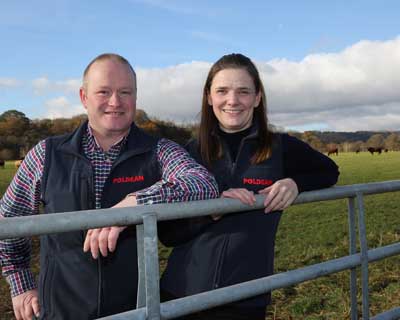Alisdair and Emma Davidson farm 850 hectares (ha), at Poldean near Moffat, Dumfries and Galoway.
The husband and wife team runs a herd of 360 Salers cows calved to mainly Charolais bulls and have adapted their enterprise from an intensive system to one that better utilises grass all year round.
“We started dabbling with paddock grazing through Quality Meat Scotland’s (QMS) Better Grazing Group and that’s when we started seeing great benefits, particularly with cows and calves,” said Mr Davidson.
“I knew I could improve the grassland, but couldn’t quantify how well, so the opportunity to be a pilot farm for the GrassCheck GB Programme helped me with the discipline to regularly measure and utilise the farm’s grass.
“I am now managing to quantify how much grass there is, so I can predict how much I have to feed stock. We grew a lot of grass last year; one paddock grew close to 18 tonnes dry matter per hectare (T DM/Ha) which I never thought we could manage here in Moffat,” he added.
GrassCheck GB monitors the growth and quality of pasture, making predictions of future growth utilisation on beef and sheep farms. Each unit is equipped with weather stations and other monitoring devices to report on the factors that influence pasture growth and quality, combined with measures of animal performance.
“Historically we lambed from 1st April and continued to feed with the snacker until May. We now lamb at the end of April to allow grass to establish, so the ewes can milk better. The same theory has been applied with the cattle, and we calve earlier at the start of April, to make best use of grass when the cows need it most,” said Mr Davidson.
A bespoke electric fencing system has been set up at Poldean, which allows them to rotate cattle in the paddocks without spending a large amount of time putting up and taking down fences.
Mr Davidson added: “I did a lot of research and tried various off the shelf electric fencing systems, but nothing allowed for a simple system that would save time. Our local smiddy helped us manufacture posts, spring gates and cattle grids to give us enough infastructure to rotate stock without the need to take down and put fences back up in new paddocks. We are continually reviewing and adapting the system, but our efforts so far have made the job much quicker and more efficient.
“Livestock flow has been a big consideration in fencing layout. Cows and calves need a lot of water, so we have also spent a lot of time and investment installing water systems throughout the paddocks.”
Cows calve outside and are paddock grazed in as few groups as possible – ideally around 120 cows and their calves.
“Having larger batches makes for a simpler system requiring less stock movement, with cows moved every three to four days in paddocks of around 3-4ha.”
Last year, April born calves were weaned and sold straight off their mothers in October, fed no concentrates and averaged 1.5kg daily liveweight gain (DLWG). The remainder of the youngstock were wintered and sold in the spring.
To enable Mr and Mrs Davidson to breed their own heifer replacements that suit the system at Poldean, they have recently introduced a Red Angus bull. The aim is to bring some high bred vigour into the cows while still maintaining a uniform looking herd which, when crossed with the Charloias produces a ginger calf – something Mr Davidson loves to sell through the market.
“My cows have to be able to calve unassisted. The Salers cow is good, but we’re hoping that the Red Angus will help flesh out progeny a little easier on the grass system we have.”
Sheep are loosely rotated on a weekly basis after lambing, grazing 20ha blocks of rough ground. Once weaned, at approximately 30kg, the lambs are then put onto the paddock grazing system to utilise the best of the grass for finishing.
“Rotational and/or paddock grazing gives you huge flexibility,” says Mr Davidson. If you can build grass stocks into the back end, it can help cheapen your winter.
“We are now stocking more cattle, but still have a full silage pit that we haven’t touched – so it’s definitely given us the opportunity to be more resilient and reduce our costs of fertiliser and feeding stock, whilst still allowing us to increase cattle numbers.”
Mrs Davidson concludes: “Our ultimate goal is to produce a product that the market wants in as efficient way as possible by making the best use of the key natural resource we have available to us. You really can’t put a price on what you can grow in your fields.”





